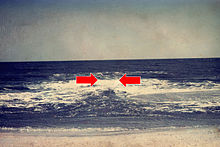- Not to be confused with drinking water, which is covered in the "Water" article.
Being by water is something that can't be taken lightly, especially if there are young kids. Depending on the area, there may be several dangers involved in swimming and other activities by the beach, such as tides, currents, wildlife and seabed features, some not obvious. You need to keep eyes on young kids at all times. Unless at an organized beach, you should seek local advice.
Potential dangers
[edit]- At ocean beaches, there are often rip currents that can take a swimmer out to sea, caused by tides or waves (even in still weather). Areas within a mile of straights have pronounced rip currents.
- Drop-offs, due to constantly changing topography.
- Fishing nets, submerged trees and other obstacles could get you trapped.
- Quicksand and other seabed features could have similar effects.
- Jellyfish, sharks and other wildlife
- Tsunamis and storms can be particularly dangerous to people at the beach or out at sea. While you can see how high the biggest normal waves reach, now and then there are rare rogue waves, which may be twice their size.
- Quays and cliffs by the water may be slippery. Even if not, a child can easily lose their balance and fall into deep water (or you, if there is crowding or tumult).
Watching your party
[edit]Remember that if somebody is going to drown because of fatigue, inhaled water or a heart attack, he or she will not have any opportunity to scream, but will just disappear – contrary to what you see on TV. Keep a close look at least on children. Swimming in pairs is a good way to make sure everybody is being watched by somebody at all times.
If there are lifeguards, that doesn't affect your responsibility to watch your company: they have no possibility to see that somebody disappears. Instead, their duty is to come and help once you alert them.
Floating devices
[edit]The warnings on some floating devices, that they may only be used under supervision, are not exaggerated: e.g. swim tubes can turn upside down, creating a very dangerous situation, or they can take a child to deep water where the child may slip out of it. Proper life vests and lifebuoys are differently constructed.
Rip currents
[edit]
Rip currents are the returning flow from waves breaking off the beach, often at a reef or similar. Due to the underwater topology, the return flow is concentrated at a few deeper sections, and a fast current to deep water may form there. Most deaths happen as result of fatigue trying to swim back against the current, which may be impossible. Instead either swim in parallel to the shore, i.e. perpendicular to the current, or just wait it out (calling for help), as it loses its force outside the surf zone. As soon as you get out of the current, swimming back is no more difficult than normally. Try aiming somewhere where you are not caught again or, depending on your skills and on whether you have been noticed, you might want to wait for rescue.
Rescuing
[edit]If somebody disappears, watch the point of disappearance closely while calling for help. If others can help, it is better that you direct the help to the right location than that also you lose it by getting distracted.
Make sure somebody calls the appropriate authority for help (112, 911 or similar). If you are not the one staring at the point of disappearance, make sure that that person doesn't have to take care of anything else and doesn't get disturbed.
Unless you have rescue training or are rescuing a small child, always have some device between you and the victim; a person scared of drowning can drag you into the deep. Have a look for possible aids already when arriving: lifebuoys, oars, poles, surfboards etc.
A rescued person often needs medical care even if they are conscious: they may be cold and they can have breathed water, which isn't healthy.
If a rescued person became unconscious and stopped breathing, they can often be saved by mouth-to-mouth resuscitation. Don't get scared by the water they might have got in their lungs, just continue. For adults, you usually need to bend their head slightly backwards to open their airways. Give the victim air in the same pace and quantity as by normal breathing (unless you do full CPR). Having attended a course drastically increases your chances, but even an unskilled try may succeed. Don't stop before somebody else takes over, the victim breathes normally or you just cannot do it any more. Taking turns helps keeping it going.

